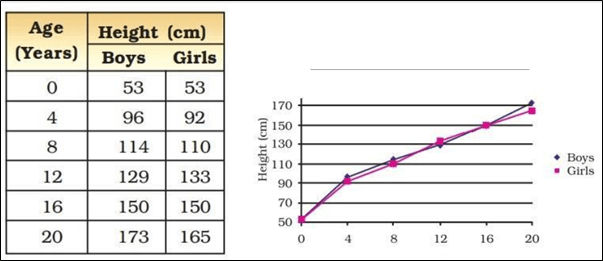NCERT Solutions for Class 8 Science Chapter 7 Reaching The Age of Adolescence help students to clear all their doubts. These solutions provide you with the answers to all the questions given in the NCERT textbook. CBSE Class 8 Science Chapter 7 Solutions is prepared by expert teachers as per the latest CBSE syllabus and guidelines.
Solving NCERT Solutions will help you to understand the concepts related to Reaching The Age of Adolescence. NCERT Solutions for Class 8 Science Chapter 7 contains an in-depth explanation of each question of NCERT Science textbook. These solutions cover important concepts in different patterns like MCQs and short answer questions, worksheets and more and help you top score good marks in the exam.
Class 8 Science Reaching The Age of Adolescence Questions and Answers
Exercise Questions
Question 1: What is the term used for secretions of endocrine glands responsible for changes taking place in the body?
Answer: Hormones are chemical messengers that transport signal from one cell (or gland) to another cell (or gland).
Question 2: Define adolescence.
Answer: The period of life, when the body undergoes changes, leading to reproductive maturity, is called adolescence. Adolescence begins around the age of 11 and lasts upto 18 or 19 years of age.
Question 3: What is menstruation? Explain.
Answer: In female ovaries, the ova begin to mature with the onset of puberty. One ovum matures and released by one of the ovaries once in about 28 to 30 days. During this period, the wall of the uterus becomes thick so as to receive the egg, in case it is fertilized and begins to develop. If fertilization does not occur, the released egg and the thickened lining of the uterus along with its blood vessels are shed off. This causes bleeding in female which is called menstruation. Menstruation occurs once in about 28 to 30 days.
Question 4: List changes in the body that take place at puberty.
Answer: Common changes occur among boys and girls during puberty:
- Sudden increase in height.
- Change in body shape.
- Change in voice. In boys voice becomes deep and harsh, in girls it is high pitched voice.
- Increased activity of sweat and sebaceous glands.
- Reproductive organs begin to mature.
- Appearance of secondary sexual characteristics.
Changes in Boys during puberty:
- Facial hairs such as beard and moustaches develop.
- Hair develops under the armpit, under chest and in the pubic regions.
- Voice becomes deeper.
- Muscles develop, and shoulder becomes broad.
- Increase in weight.
Changes in Girls during puberty:
- Development and enlargement of breasts.
- Hair develops under the armpit and in the pubic regions.
- Hips broaden and pelvic region widens.
- Initiation of menstrual cycle.
- Deposition of fat around hips.
Question 5: Prepare a Table having two columns depicting names of endocrine glands and hormones secreted by them.
Answer 5:
| Endocrine Gland | Hormone Secreted |
| Pituitary | Growth Hormones |
| Thyroid | Thyroxine |
| Adrenal | Adrenalin |
| Pancreas | Insulin |
| Testes | Testosterone |
| Ovaries | Oestrogen & Progesterone |
Question 6: What are sex hormones? Why are they named so? State their function.
Answer: Hormones which constitute the secondary sexual characters are called sex hormones. In general, hormones work instantly when they released in bloodstream. Sex hormones are different because they start to work later on. They gradually prepare in the body for reproduction.
The sex hormones are responsible for the fundamental change in growth & development and stimulate the developments of secondary sexual characters. The testes and the ovaries are the reproductive Organs and both are stimulated by the pituitary hormone during Puberty. That’s the reason these are called sex hormones.
Functions of Sex Hormones:
- In male, the testes produces the male sex hormone testosterone. This hormone helps in the development and maintenance of the primary and secondary sexual characters and production of sperms.
- In female, the ovaries secrete oestrogen and progesterone responsible for the primary and secondary sexual characters.
Question 7: Choose the correct option.
(a) Adolescents should be careful about what they eat, because
(i) proper diet develops their brains.
(ii) proper diet is needed for the rapid growth taking place in their body.
(iii) adolescents feel hungry all the time.
(iv) taste buds are well developed in teenagers.
Answer: (ii) proper diet is needed for the rapid growth taking place in their body.
(b) Reproductive age in women starts when their
(i) menstruation starts.
(ii) breasts start developing.
(iii) body weight increases.
(iv) height increases.
Answer: (i) menstruation starts.
(c) The right meal for adolescents consists of
(i) chips, noodles, coke.
(ii) chapati, dal, vegetables.
(iii) rice, noodles and burger.
(iv) vegetable cutlets, chips and lemon drink.
Answer: (ii) chapati, dal, vegetables.
Question 8: Write notes on—
(a) Adam’s apple.
(b) Secondary sexual characters.
(c) Sex determination in the unborn baby.
Answer: (a) Adam’s apple: The protruding part of the throat is called Adam’s apple. It is the enlarged voice box or larynx which gets enlarged and visible from outside in boys at the onset of puberty. This makes the voice of boys hoarse.
(b) Secondary sexual characters: Secondary Sexual Characters are those characters which distinguish a male from female. Some of the characters are as follows:
Boys
- Facial hairs such as beard and moustaches develop.
- Hair develops under the armpit, under chest and in the pubic regions.
- Voice becomes deeper.
- Muscles develop, and shoulder becomes broad.
- Increase in weight.
Girls:
- Development and enlargement of breasts.
- Hair develops under the armpit and in the pubic regions.
- Hips broaden and pelvic region widens.
- Initiation of menstrual cycle.
- Deposition of fat around hips.
(c) Sex determination in the unborn baby: All human beings have 23 pairs of chromosomes in the nuclei of their cells. Out of these two chromosomes are the sex chromosomes, named X and Y. A female has two X chromosomes, while a male has one X and one Y chromosome. The gametes (egg and sperm) have only one set of chromosomes. The unfertilised egg always has one X chromosome but sperms may have X or Y. When a sperm containing X chromosome fertilises the egg, the zygote would have two X chromosomes and develop into a female child. If the sperm contributes a Y chromosome to the egg (ovum) at fertilisation, the zygote would develop into a male child. This concludes that the sex chromosomes of the father determine the sex of an unborn baby.
Question 9: Word game: Use the clues to work out the words.
Across
3. Protruding voice box in boys
4. Glands without ducts
7. Endocrine gland attached to brain
8. Secretion of endocrine glands
9. Pancreatic hormone
10. Female hormone
Down
1. Male hormone
2. Secretes thyroxine
3. Another term for teenage
5. Hormone reaches here through blood stream
6. Voice box
7. Term for changes at adolescence

Answer:
Across
3. Adam’s apple
4. Endocrine
7. Pituitary
8. Hormone
9. Insulin
10. Estrogen
Down
1. Testosterone
2. Thyroid
3. Adolescence
5. Target site
6. Larynx
7. Puberty

Question 10: The table below shows the data on likely heights of boys and girls as they grow in age. Draw graphs showing height and age for both boys and girls on the same graph paper. What conclusions can be drawn from these graphs?

Answer: Girls are taller than boys until they reach the age of 12 years.
Till the age of 16 years, the height of both boys and girls remain the same.
After 16, both boys and girls gain an increase in height. In general, boys are taller than girls.